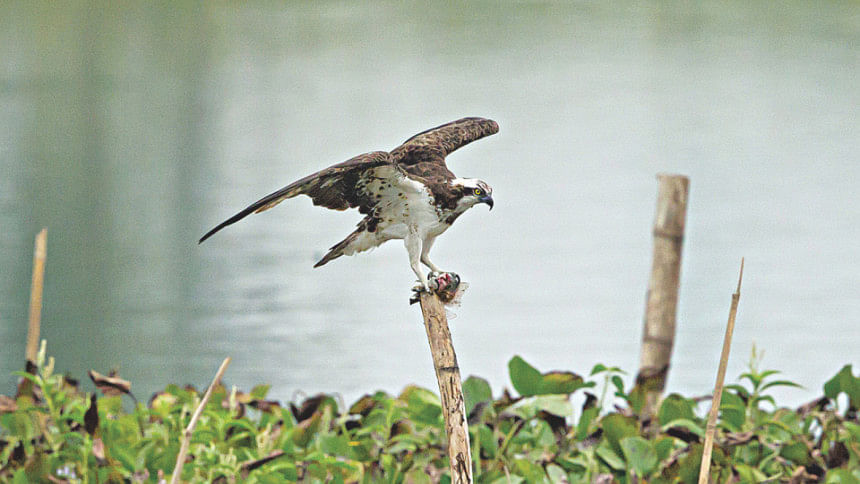Osprey

If there ever was a Shakespearean bird, the osprey is it. Its dramatic appearance, its single minded pursuit of prey, the fierce manner in which it catches and eats it – all these remind us of fate, of the forceful characters in Shakespeare.
The osprey's love of catching fish has been known for centuries. Some people think that fish are paralyzed with fear when they see an osprey circling overhead.
I first saw an osprey (mach murali, pandion haliaetus) from a boat on the way to Sundarban several years ago. The boat's approach had disturbed its meal. As it took off carrying a half-eaten fish in its claws, its striking appearance – the black band around the eyes, the black and white wing pattern – caught my attention. Looking at my photograph later, I saw the bird was carrying the fish aligned with the direction of flight. This was no accident – ospreys carry their fish in a way to minimize wind resistance.
But the bird is rare in Bangladesh, and the next few years I only saw it twice more from a distance, over the Haors. Then, earlier this year, I visited the Jamaica Bay Wildlife Refuge in New York which has a man-made osprey breeding center. That summer morning, an osprey alternately perched on the top of a tall tree and circled the water. When it fished, it dived from a great height, plunging into the water and clutching its prey in its talons as it emerged. Sometimes it skimmed the water – like a water ski - for fish.
Indeed, the osprey's entire physique is adapted to catching fish. The soles of its feet are covered with thorny spines and its long claws cover a wide range of motion. Its nostrils have valves which close when the bird is underwater to prevent water from entering. Its feathers dry quickly and its wings are long and narrow to enable it to fly great lengths as it looks for fish.
Recently I had a stroke of good luck when one afternoon early November I saw an osprey in Hail Haor, Moulvi Bazar. It was sitting on a pole in the middle of a large fisheries pond, about 200-300 feet from me. It had caught a fish which it was holding with one claw. As it slowly ate – savoured perhaps? – the fish, it kept a sharp eye out for possible predators coming to snatch it away.
Returning to Shakespeare, the osprey appears in his play Coriolanus. The context is revealing: the great Roman general Coriolanus has been driven out of Rome. His lieutenants are discussing how he can return to take over Rome. One of them expresses his confidence about the general's chances in such a venture:
I think he'll be to Rome
As is the osprey to the fish,
who takes it
By sovereignty of nature.
Unfortunately the general was not quite as successful as the osprey, which catches fish four out of five attempts. But that is another story.
www.facebook.com/tangents.ikabir

 For all latest news, follow The Daily Star's Google News channel.
For all latest news, follow The Daily Star's Google News channel. 



Comments